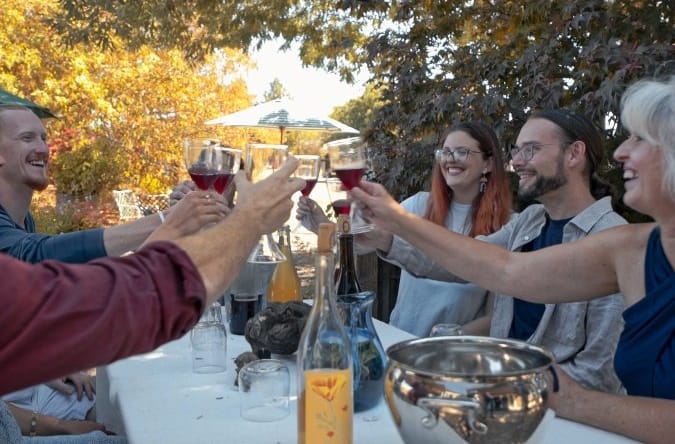
Lori Miller was inspired to make her new natural wine documentary, Living Wine, after her brother’s home burned down in the 2017 Tubbs Fire that destroyed a large portion of Santa Rosa, California. Everything seemed fine once he and his family moved to a new property in town that included a small vineyard — but they soon experienced one of the shocking realities of the commercial wine industry in their own backyard.
“They wanted to make their own wine,” Miller told MovieMaker. And they were excited to start – until the harsh pesticides that were being sprayed on their vines began to seep into their water table and contaminate the well water that their children drank every day.
“Because the property is off the grid, all their drinking water comes from a well and not the city water,” Miller said. “There was a management company that was coming and tending to the vines, and they watched them, over the months after they moved in, spraying these chemical inputs on the vines. You know, pesticides and herbicides. By the time they got to summer, they were coming every two weeks and spraying roundup on their vines, which was obviously getting into their water table and into their drinking water for their family.”
It turns out, harsh pesticides like Roundup are commonly used when growing wine grapes — and once they’re juiced, so are chemical additives called processing aids.
After Miller’s brother told her what he and his family experienced, he introduced her to Darek Trowbridge, a local California winemaker interviewed in Living Wine whose Old World Winery is organic, sustainable, and Roundup-free. But the hallmarks of natural wine don’t just take place while the grapes are being grown. The wine itself is also free from any unnatural processing aids that most conventional wineries use to manipulate the wine’s color and taste in order to achieve a consistent product year after year.
Also Read: Ethan Hawke on The Last Movie Stars and the Call That Hijacked His Life (Video)
The resulting “natural” wine is a true reflection of the land and the environment it came from that year.
There’s a happy ending for Miller’s brother and his family. Trowbridge helped them convert their vines to use the same regenerative farming practices that he uses on his farm, eliminating the Roundup runoff into their water table.
“It sort of started a journey for me to read about how wine is made because I was completely unaware. I assume that wine that I would buy wherever — at Whole Foods or Ralph’s — was a natural beverage, when in fact, there’s no way to know how the grapes were farmed from the bottle of wine that you’re drinking,” Miller said.
“You don’t know if chemical inputs have been used, or even if negative environmental practices have been used to make the wine. There’s no way a consumer would know that,” she added. “And then I started to learn about the certain sort of more artistic side of wine… natural wine is a pure expression of the place that the grapes come from, whereas conventional wines, in order to make those wines, there’s a lot of manipulation that occurs to make the taste, I would say, consistent from vintage to vintage, from bottle to bottle.”
Living Wine also points out the about-face turn that the winemaking industry has undergone in just the last 100 years.
“Before the advent of chemical fertilizers in industrial agriculture, all wine was made this way,” Miller said. “So this is sort of a modern, corporate idea of wine that we’ve all become accustomed to.”
Living Wine is now playing in select theaters. To learn more about the winemakers featured in the documentary and to see a list of theaters where it’s playing, visit the movie’s website here.
Watch an exclusive clip from Living Wine below:
Main Image: A still from Living Wine courtesy of Abramorama.
Share:

